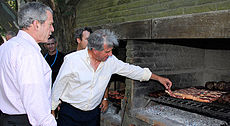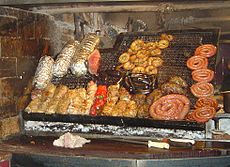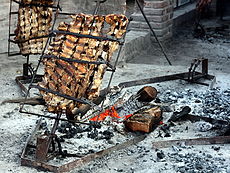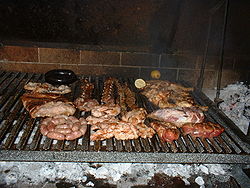- Asado
-
Asado is a term used both for a range of barbecue techniques and the social event of having or attending a barbecue in Argentina, Uruguay, Paraguay, Chile and southern Brazil. In the former countries asado is also the standard word for barbecue. An asado usually consists of beef alongside various other meats, which are cooked on a grill, called a parrilla, or open fire. It is considered a traditional dish in Argentina, Uruguay, Paraguay, Chile, and Brazil.
 Asado de tira (Flanken-cut Short ribs)
Asado de tira (Flanken-cut Short ribs) Asado with achuras (offal) and sausages
Asado with achuras (offal) and sausages
 Former President of Uruguay Tabaré Vázquez welcomes former U.S. President George W. Bush with asado a la parrilla
Former President of Uruguay Tabaré Vázquez welcomes former U.S. President George W. Bush with asado a la parrilla
Contents
Organization
Food can be prepared either by an assigned asador (barbecu-er) or parrillero (griller), the (cook), which is common in more formal events and restaurants or done in a more collective manner by volunteers which is more common in informal and relaxed settings.
Coal and fire
Usually the Asado will begin by igniting the coal. The coal will usually be made of native trees avoiding pines and eucalyptus that have strong-smelling resins. In more sophisticated Asados the coal would be of a specific tree or made on the coal of recently burned wood, which is also the commonplace when having an Asado in a campfire. In Uruguay charcoal is not used but direct embers or hot coals instead.
Cooking can be done al asador or a la parrilla. In the first case a fire is made on the ground or in a fire pit and surrounded by metal crosses (asadores) that hold the entire carcass of an animal splayed open to receive the heat from the fire. In the second case a fire is made and after the coals have formed, a grill with the meat is placed over.
Composition
An Asado may consist of embutidos, meats or both. Usually in more elaborate versions the embutidos or meats are accompanied by red wine and salads.
Embutidos
In many Asados chorizos, morcillas (black pudding), chinchulines (cow chitterlings), mollejas (sweetbread) and other organs, often accompanied by provoleta would be served first while the cuts that require longer preparations are still on the grill. Sometimes these are served on a coal-heated brasero. Chorizos may be served with marraqueta or baguette bread as choripanes to serve as appetizers.
Meats
After appetizers, costillas or asado de tira (ribs) can be served. Next comes vacío (flank steak), matambre and possibly chicken and chivito (goatling).[1] Dishes such as the Uruguayan Pamplona, pork and Patagonian lamb are becoming more frequent, particularly in restaurants. An Asado also includes bread, a simple mixed salad of, for instance, lettuce, tomato and onions, or it could be accompanied with verdurajo (grilled vegetables), a mixture made of potatoes, corn, onion and eggplant cooked on the grill and seasoned with olive oil and salt. Beer, wine, soda and other beverages are common. Dessert is usually fresh fruit.
Another traditional form to mainly roast the meat, used in the Argentine and Chilean Patagonia, is with the whole animal (especially lamb and pork) in a wood stick nailed in the ground and exposed to the heat of live coals, called asado al palo.
The meat for an Asado is not marinated, the only preparation being the application of salt before and/or during the cooking period. Also, the heat and distance from the coals are controlled to provide a slow cooking; it usually takes around two hours to cook asado. Further, grease from the meat is not encouraged to fall on the coals and create smoke which would adversely flavour the meat. In some asados the area directly under the meat is kept clear of coals.
The asado is usually placed in a tray to be immediately served, but it can also be placed on a brasero right on the table to keep the meat warm. Chimichurri, a sauce of chopped parsley, dried oregano, garlic, salt, pepper, onion, and paprika with olive oil, or salsa criolla, a sauce of tomato and onion in vinegar, are common accompaniments to an asado, where they are traditionally used on the offal, but not the steaks.
Salad
Food is often accompanied by salads, which in collective Asado gatherings are traditionally made by women on site or brought to the Asado from their homes while the men focus on the meats. Salad Olivier (Spanish: Ensalada rusa) is one of the most common salads served at Asados.
Variations
In Chile, the local version Cordero al palo (Whole Roast Lamb) is usually accompanied with pebre, a local condiment made from pureed herbs, garlic and hot peppers; in many ways similar to chimichurri. The dish is typical of the South of Chile and is served hot accompanied by various salad vegetables. A whole lamb is tied to a spit and is then roasted perpendicular on a wood fire. The preparation lasts around 5 hours since cooking must be constant and on a low heat.
This is not to be confused with asado in the Philippines which is a dish cooked in a sweet tomato-based stew that is usually accompanied by potatoes, carrots and other vegetables. Being true to its distinct East-meets-West cultural roots, Philippine asado is also used as a filling in siopao (Chinese: 燒包; Pe̍h-ōe-jī: sio-pau), a Philippine version of bāozi (包子). There is also Chinese asado in the Philippines, which really refers to dried sweetmeats as well as dried red-colored meats with sweet taste that are actually Char siu.
In Brazil, asado is called churrasco, although the cooking is usually faster. Charcoal is predominantly used instead of embers of wood, and Brazilians tend to cook the meat on skewers or grills. In some places, the meat is seasoned with salt and a bit of sugar[citation needed].
In Mexico, there exists a similar tradition known as "parrilladas" which incorporates various marinated cuts of meat, including steaks, chicken, and sausages (longaniza, chorizo, and moronga being especially popular). These are all grilled over wood charcoal. Vegetables are also placed over the grill, especially green onions (cebollitas), nopales, and corn (elote).
Again in Argentina, Paraguay and Uruguay some alternatives are the asado al disco and asado al horno de barro, specially in the countryside. The recipe doesn't change, only the way of cooking. In the asado al disco the worn out disc of a plough is used. Being metallic and concave, three or four metallic legs are welded and with hot coal or lumber below its easily transformed into a very effective grill. Food is put in a spiral, in such a way that the fat naturally slips to the center, preserving the meat for being fried. Chili peppers and onions are usually put next to the edge, so that they gradually release their juices on the meat. The asado al horno de barro differs from tradition, as an horno (adobe oven) is used. These primitive ovens are a common view in Argentine estancias, and their primary function is to bake bread, but they are well suited for roasting meat. Pork suckling and, less commonly, lamb are served, as they are more unlikely to get dry. Though not technically a grill, it is a very traditional way of cooking that still requires the great skills of an asador and the gathering of family and friends, which are the essence of an Asado. Moreover, the smoky flavour and tenderness of these dishes are very appreciated.
See also
- Cuisine of Argentina
- Cuisine of Uruguay
- Cuisine of Chile
- Argentine beef
- Barbecue
- Char siu
Notes
- ^ "Chivito" in Argentina means goatling and in Uruguay it's a beef sandwich with cheese, ham, bacon, boiled eggs, lettuce, tomato, mayonnaise and onions, which is unrelated.
External links
- Argentine Barbecue
- Sample recipe from the Australian Broadcasting Corporation
- Asado Argentina
- Café Columbus This article is half in Spanish, half in English.
- From Uruguay - Asado (English)
- Photographic Journal & Travel Through Uruguay
 National emblems of Argentina
National emblems of ArgentinaCoat of arms · Father of the fatherland · National animal · National anthem · National cockade · National dish · National flag · National flower · National liquor · National motto · National personification · National sport · National stone · Official logo · Patron saint · Provincial flags · Sun of May
Categories:- National symbols of Argentina
- Argentine cuisine
- Chilean cuisine
- Uruguayan cuisine
- Philippine cuisine
- Barbecue
Wikimedia Foundation. 2010.



